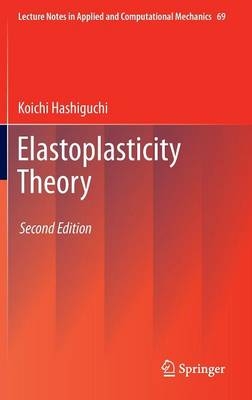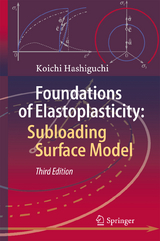Elastoplasticity Theory
Seiten
2013
|
2nd ed. 2014
Springer Berlin (Verlag)
978-3-642-35848-7 (ISBN)
Springer Berlin (Verlag)
978-3-642-35848-7 (ISBN)
- Titel erscheint in neuer Auflage
- Artikel merken
Zu diesem Artikel existiert eine Nachauflage
This book serves as the standard textbook on elastoplasticity for students, engineers and researchers in applied mechanics. It explains physical concepts in elastoplasticity in detail and offers formulations and derivations/transformations for all equations.
This book was written to serve as the standard textbook of elastoplasticity for students, engineers and researchers in the field of applied mechanics. The present second edition is improved thoroughly from the first edition by selecting the standard theories from various formulations and models, which are required to study the essentials of elastoplasticity steadily and effectively and will remain universally in the history of elastoplasticity. It opens with an explanation of vector-tensor analysis and continuum mechanics as a foundation to study elastoplasticity theory, extending over various strain and stress tensors and their rates. Subsequently, constitutive equations of elastoplastic and viscoplastic deformations for monotonic, cyclic and non-proportional loading behavior in a general rate and their applications to metals and soils are described in detail, and constitutive equations of friction behavior between solids and its application to the prediction of stick-slip phenomena are delineated. In addition, the return-mapping algorithm, the consistent tangent operators and the objective time-integration algorithm of rate tensor are explained in order to enforce the FEM analyses. All the derivation processes and formulations of equations are described in detail without an abbreviation throughout the book.The distinguishable features and importance of this book is the comprehensive description of fundamental concepts and formulations including the objectivity of tensor and constitutive equations, the objective time-derivative of tensor functions, the associated flow rule, the loading criterion, the continuity and smoothness conditions and their substantial physical interpretations in addition to the wide classes of reversible/irreversible constitutive equations of solids and friction behavior between solids.
This book was written to serve as the standard textbook of elastoplasticity for students, engineers and researchers in the field of applied mechanics. The present second edition is improved thoroughly from the first edition by selecting the standard theories from various formulations and models, which are required to study the essentials of elastoplasticity steadily and effectively and will remain universally in the history of elastoplasticity. It opens with an explanation of vector-tensor analysis and continuum mechanics as a foundation to study elastoplasticity theory, extending over various strain and stress tensors and their rates. Subsequently, constitutive equations of elastoplastic and viscoplastic deformations for monotonic, cyclic and non-proportional loading behavior in a general rate and their applications to metals and soils are described in detail, and constitutive equations of friction behavior between solids and its application to the prediction of stick-slip phenomena are delineated. In addition, the return-mapping algorithm, the consistent tangent operators and the objective time-integration algorithm of rate tensor are explained in order to enforce the FEM analyses. All the derivation processes and formulations of equations are described in detail without an abbreviation throughout the book.The distinguishable features and importance of this book is the comprehensive description of fundamental concepts and formulations including the objectivity of tensor and constitutive equations, the objective time-derivative of tensor functions, the associated flow rule, the loading criterion, the continuity and smoothness conditions and their substantial physical interpretations in addition to the wide classes of reversible/irreversible constitutive equations of solids and friction behavior between solids.
Tensor Analysis.- Motion and Strain (rate).- Conservation Laws and Stress Tensors.- Objectivity and Objective and Corotational Rate Tensors.- Elastic Constitutive Equations.- Basic Formulations for Elastoplastic Constitutive Equations.- Unconventional Elastoplasticity Model: Subloading Surface Model.- Cyclic Plasticity Model: Critical Reviews and Assessments.- Extended Subloading Surface Model.- Chapter 10 Constitutive Equations of Metals.- Constitutive Equations of Soils.- Viscoplastic Constitutive Equations.- Corotational Rate Tensor.- Localization of Deformation.- Constitutive Equation for Friction: Subloading-friction Model.- Return-mapping and Consistent Tangent Modulus.
| Reihe/Serie | Lecture Notes in Applied and Computational Mechanics |
|---|---|
| Zusatzinfo | XVIII, 455 p. |
| Verlagsort | Berlin |
| Sprache | englisch |
| Maße | 155 x 235 mm |
| Gewicht | 872 g |
| Themenwelt | Mathematik / Informatik ► Mathematik ► Wahrscheinlichkeit / Kombinatorik |
| Technik ► Maschinenbau | |
| Schlagworte | Constitutive equation of friction • Constitutive equations of metals and soils • Elastizität • Elastoplastic constitutive equation • Plastizität • Viscoplastic constitutive equation |
| ISBN-10 | 3-642-35848-9 / 3642358489 |
| ISBN-13 | 978-3-642-35848-7 / 9783642358487 |
| Zustand | Neuware |
| Informationen gemäß Produktsicherheitsverordnung (GPSR) | |
| Haben Sie eine Frage zum Produkt? |
Mehr entdecken
aus dem Bereich
aus dem Bereich
Buch | Softcover (2024)
Springer Spektrum (Verlag)
44,99 €
Buch | Hardcover (2023)
Wiley-VCH (Verlag)
99,00 €





